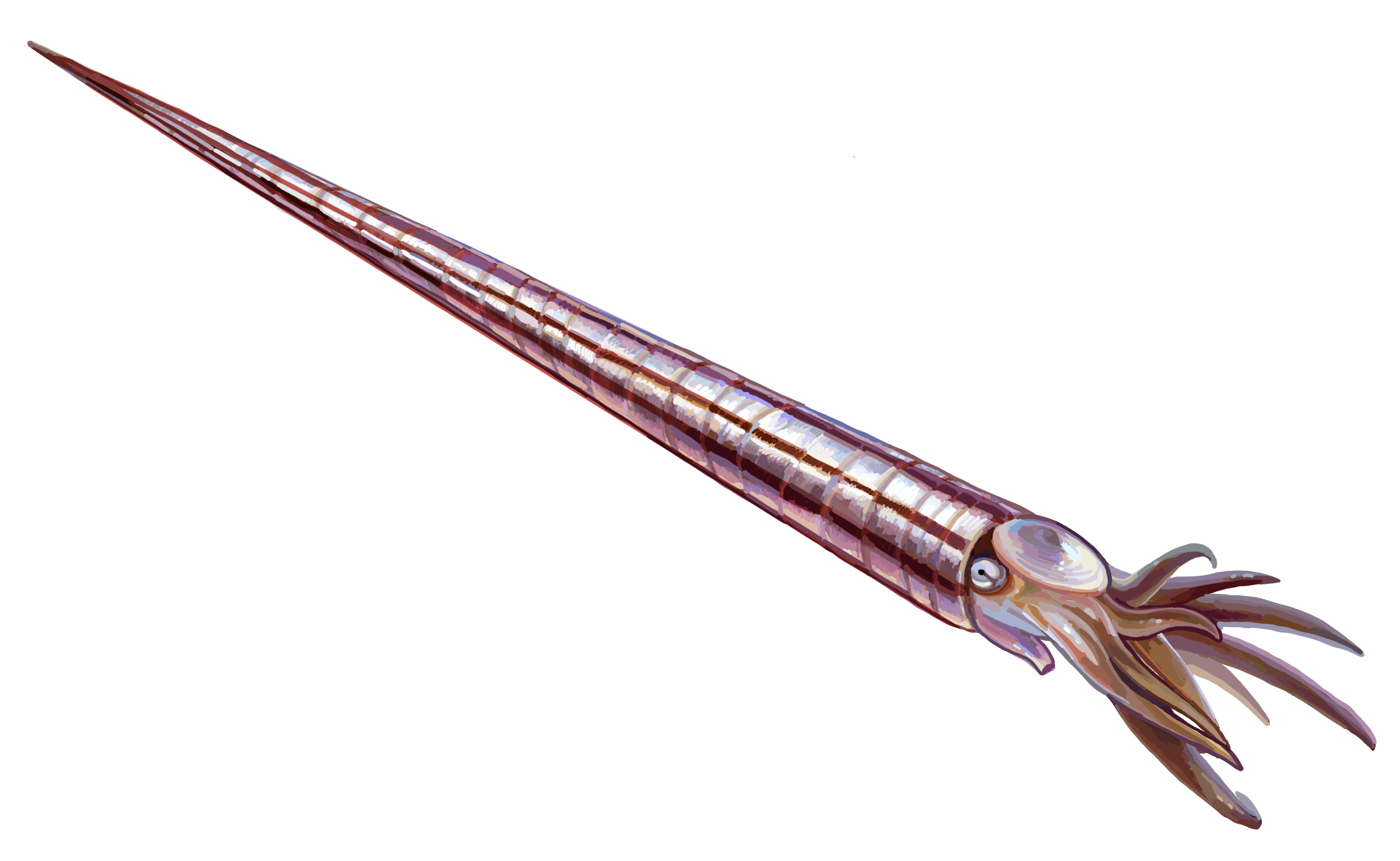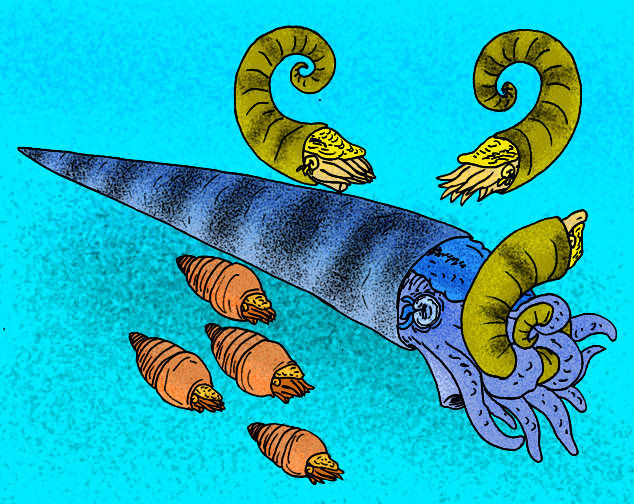|
Endocerid
Endocerida is an extinct Nautiloidea, nautiloid order, a group of cephalopods from the Lower Paleozoic with cone-like deposits in their siphuncle. Endocerida was a diverse group of cephalopods that lived from the Early Ordovician possibly to the Late Silurian. Their shells were variable in form. Some were straight (orthoconic), others curved (cyrtoconic); some were long (longiconic), others short (breviconic). Some long-shelled forms like ''Endoceras'' attained shell lengths close to . The related ''Cameroceras'' is anecdotally reported to have reached lengths approaching , but these claims are problematic. The overwhelming majority of endocerids and nautiloids in general are much smaller, usually less than a meter long when fully grown. Morphology Endocerids had a relatively small body chamber as well as a proportionally large siphuncle, which in some genera reached nearly half the shell diameter. This suggests that much of the visceral mass may have been housed within the sip ... [...More Info...] [...Related Items...] OR: [Wikipedia] [Google] [Baidu] |
Bisonocerida
Bisonocerida is an order of Ordovician to Silurian nautiloid cephalopods. Members of this order were originally placed in the order Endocerida, but later investigation argued that this broad usage of Endocerida was a polyphyletic assemblage encompassing two different groups of independent origin. Bisonocerida was differentiated from Endocerida in 2012 in order to resolve this issue. Bisonocerids are similar to endocerids in many respects. The siphuncle was broad and positioned ventrally in the shell, which ranged in shape from cyrtoconic brevicones (curved and short) to rare orthoconic longicones (straight and long). The inner surface of the siphuncle contains endosiphuncular deposits, which help distinguish the two orders. In both bisonocerids and endocerids, the endosiphuncular deposits are conical in shape ("endocones"), concreted from the rim of the siphuncle and tapering towards the apex of the shell. Both orders possess simple perforate endocones, with a hole at the tip of ... [...More Info...] [...Related Items...] OR: [Wikipedia] [Google] [Baidu] |
Allotrioceras
''Allotrioceras'' is a tubular fossil from the Middle Ordovician of the state of New York, collected by Rousseau H. Flower; included by him in the Endocerida and placed in a new family, the Allotrioceratidae. ''Allotrioceras'' is characterized by a lateral pair of subequal conical structures, resembling the endocones of endocerids, separated by a straight partition that extends more than half way across from either the dorsal or ventral side, as perceived, and runs along the length. What remains is thought to represent a siphuncle, which ranges from about 8 millimeters (0.3 in) to about 15 millimeters (0.6 in) in diameter. On the basis of diagnosis, inclusion of ''Allotrioceras'' and the Allotrioceratidae, for which it is the type, in the endocerida seems at best tentative. Some endocerids, derived from the Proterocameroceratidae, ''Najaceras'', '' Cacheoceras'', and ''Williamsoceras'', have a longitudinal dorsal or ventral process, or both about which the endocones are ... [...More Info...] [...Related Items...] OR: [Wikipedia] [Google] [Baidu] |
Cameroceras
''Cameroceras'' ("chambered horn") is a genus of extinct, giant orthoconic cephalopod that lived mainly during the Ordovician period. It first appears during the middle Ordovician, around 470 million years ago, and was a fairly common component of the fauna in some places during the period, inhabiting the shallow seas of Laurentia, Baltica and Siberia.Frey, R.C. 1995. U.S. Geological Survey, p.73 Its diversity and abundance became severely reduced following the Ordovician–Silurian extinction events, and the last remnants of the genus went extinct sometime during the Wenlock. In older literature ''Cameroceras'' was treated as the largest nautiloid with shell length about or even , however the large-sized species is no longer belong to genus ''Cameroceras'' but ''Endoceras giganteum'', and the -long specimen is highly doubtful. Description ''Cameroceras'' is a cephalopod, a taxon of molluscs that includes the octopuses, squids and cuttlefish. From comparison with living cephalo ... [...More Info...] [...Related Items...] OR: [Wikipedia] [Google] [Baidu] |
Orthoconic
An orthocone is an unusually long straight shell of a nautiloid cephalopod.; During the 18th and 19th centuries, all shells of this type were named ''Orthoceras'', creating a wastebasket taxon, but it is now known that many groups of nautiloids developed or retained this type of shell. An orthocone can be thought of as like a ''nautilus'', but with the shell straight and uncoiled. It was previously believed that these represented the most primitive form of nautiloid, but it is now known that the earliest nautiloids had shells that were slightly curved. An orthoconic form evolved several times among cephalopods, and among nautiloid cephalopods is prevalent among the ellesmerocerids, endocerids, actinocerids, orthoceratoids, and bactritids. Orthocones existed from the Late Cambrian to the Late Triassic, but they were most common in the early Paleozoic. Revivals of the orthocone design later occurred in other cephalopod groups, notably baculitid ammonites in the Cretaceous Perio ... [...More Info...] [...Related Items...] OR: [Wikipedia] [Google] [Baidu] |
Proterocameroceratidae
The ''Proterocameroceratidae'' were the first of the Endocerida. They began early in the Ordovician with ''Proendoceras'' or similar genus which had developed endocones, replacing the diaphragms of the ellesmerocerid ancestor. Proterocameroceratids are long, straight or gently curved with a generally narrow siphuncle along the ventral margin. Septal necks are short, never quite reaching the previous septum and may vary in length ontogenically within a species. Connecting rings are thick and layered. Endocones are simple, especially in early forms but may be complex with secondary structures in later forms. The Proterocameroceratidae gave rise to the Piloceratidae early on, and later to the Manchuroceratidae and Chihlioceratidae, from which the Allotrioceratidae are derived, and later yet possibly to the Emmonsoceratidae and Najaceratidae. The Piloceratidae in turn may have given rise to the Endoceratidae although a proterocameroceratid ancestor remains possible. Proterocamerocer ... [...More Info...] [...Related Items...] OR: [Wikipedia] [Google] [Baidu] |
Nautiloidea
Nautiloids are a group of marine cephalopods (Mollusca) which originated in the Late Cambrian and are represented today by the living ''Nautilus'' and ''Allonautilus''. Fossil nautiloids are diverse and speciose, with over 2,500 recorded species. They flourished during the early Paleozoic era, when they constituted the main predatory animals. Early in their evolution, nautiloids developed an extraordinary diversity of shell shapes, including coiled morphologies and giant straight-shelled forms ( orthocones). Only a handful of rare coiled species, the nautiluses, survive to the present day. In a broad sense, "nautiloid" refers to a major cephalopod subclass or collection of subclasses (Nautiloidea ''sensu lato''). Nautiloids are typically considered one of three main groups of cephalopods, along with the extinct ammonoids (ammonites) and living coleoids (such as squid, octopus, and kin). While ammonoids and coleoids are monophyletic clades with exclusive ancestor-descendant rela ... [...More Info...] [...Related Items...] OR: [Wikipedia] [Google] [Baidu] |
Ordovician
The Ordovician ( ) is a geologic period and System (geology), system, the second of six periods of the Paleozoic Era (geology), Era. The Ordovician spans 41.6 million years from the end of the Cambrian Period million years ago (Mya) to the start of the Silurian Period Mya. The Ordovician, named after the Celtic Britons, Welsh tribe of the Ordovices, was defined by Charles Lapworth in 1879 to resolve a dispute between followers of Adam Sedgwick and Roderick Murchison, who were placing the same Rock (geology), rock beds in North Wales in the Cambrian and Silurian systems, respectively. Lapworth recognized that the fossil fauna in the disputed Stratum, strata were different from those of either the Cambrian or the Silurian systems, and placed them in a system of their own. The Ordovician received international approval in 1960 (forty years after Lapworth's death), when it was adopted as an official period of the Paleozoic Era by the International Union of Geological Sciences, Intern ... [...More Info...] [...Related Items...] OR: [Wikipedia] [Google] [Baidu] |
Orthoceratoidea
Orthoceratoidea is a major subclass of nautiloid cephalopods. Members of this subclass usually have orthoconic (straight) to slightly cyrtoconic (curved) shells, and central to subcentral siphuncles which may bear internal deposits. Orthoceratoids are also characterized by dorsomyarian muscle scars (a small number of large scars concentrated at the top of the body chamber), extensive cameral deposits, and calciosiphonate connecting rings with a porous and calcitic inner layer. Currently, Orthoceratoidea comprises the orders Riocerida, Dissidocerida, Actinocerida, Pseudorthocerida, Lituitida and Orthocerida. Orthocerida is a noteworthy paraphyletic order which is ancestral to the major cephalopod groups such as the extinct ammonoids and living coleoids (cephalopods without external shells, including squids, octopus, cuttlefish, etc.). Taxonomy As a superorder, Orthoceratiodea was one of six superorders within the Nautiloidea, the others being the Plectronoceratoidea (= Ellesm ... [...More Info...] [...Related Items...] OR: [Wikipedia] [Google] [Baidu] |
Hydrostatics
Fluid statics or hydrostatics is the branch of fluid mechanics that studies the condition of the equilibrium of a floating body and submerged body " fluids at hydrostatic equilibrium and the pressure in a fluid, or exerted by a fluid, on an immersed body". It encompasses the study of the conditions under which fluids are at rest in stable equilibrium as opposed to fluid dynamics, the study of fluids in motion. Hydrostatics is a subcategory of fluid statics, which is the study of all fluids, both compressible or incompressible, at rest. Hydrostatics is fundamental to hydraulics, the engineering of equipment for storing, transporting and using fluids. It is also relevant to geophysics and astrophysics (for example, in understanding plate tectonics and the anomalies of the Earth's gravitational field), to meteorology, to medicine (in the context of blood pressure), and many other fields. Hydrostatics offers physical explanations for many phenomena of everyday life, such as ... [...More Info...] [...Related Items...] OR: [Wikipedia] [Google] [Baidu] |
Baleen Whales
Baleen whales (systematic name Mysticeti), also known as whalebone whales, are a parvorder of carnivorous marine mammals of the infraorder Cetacea (whales, dolphins and porpoises) which use keratinaceous baleen plates (or "whalebone") in their mouths to sieve planktonic creatures from the water. Mysticeti comprises the families Balaenidae (right and bowhead whales), Balaenopteridae (rorquals and the gray whale), and Cetotheriidae (the pygmy right whale). There are currently 16 species of baleen whales. While cetaceans were historically thought to have descended from mesonychids, molecular evidence instead supports them as a clade of even-toed ungulates (Artiodactyla). Baleen whales split from toothed whales (Odontoceti) around 34 million years ago. Baleen whales range in size from the and pygmy right whale to the and blue whale, the largest known animal to have ever existed. They are sexually dimorphic. Baleen whales can have streamlined or large bodies, depending on ... [...More Info...] [...Related Items...] OR: [Wikipedia] [Google] [Baidu] |
Whale Sharks
The whale shark (''Rhincodon typus'') is a slow-moving, filter-feeding carpet shark and the largest known extant fish species. The largest confirmed individual had a length of .McClain CR, Balk MA, Benfield MC, Branch TA, Chen C, Cosgrove J, Dove ADM, Gaskins LC, Helm RR, Hochberg FG, Lee FB, Marshall A, McMurray SE, Schanche C, Stone SN, Thaler AD. 2015. "Sizing ocean giants: patterns of intraspecific size variation in marine megafauna". ''PeerJ'' 3:e715 . The whale shark holds many records for size in the animal kingdom, most notably being by far the largest living nonmammalian vertebrate. It is the sole member of the genus ''Rhincodon'' and the only extant member of the family Rhincodontidae, which belongs to the subclass Elasmobranchii in the class Chondrichthyes. Before 1984 it was classified as ''Rhiniodon'' into Rhinodontidae. The whale shark is found in open waters of the tropical oceans and is rarely found in water below . Studies looking at vertebral growth bands and ... [...More Info...] [...Related Items...] OR: [Wikipedia] [Google] [Baidu] |





